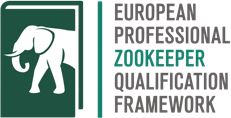Animal handling within an animal collection facilitates a huge proportion of good husbandry practises, and is thus an essential element of zookeeper competency. Many training, medical, enrichment and movement procedures require good practical animal handling skills. In order to assist breeding programs and best care, animal transporting is often necessary and zookeepers are integral in these activities. Zookeepers need to to handle animals in a way that minimises risk to both themselves and their animals, and the modern zookeeper should possess a full range of skills, attitudes and knowledge to ensure handling and transport procedures are appropriate, effective and in line with relevant legislation.
This unit links with 2.7 Animal Training, 2.9 Animal Health, and 4.6 Legislation.
- Methods of Approach and Loading: zookeepers can describe the important considerations for animal preparation, approach and loading for transportation.
- Equipment Used in Handling: zookeepers can identify appropriate equipment for restraint and safely demonstrate its use.
- Transportation Systems and Procedures: zookeepers can prepare animals for transport in accordance with Best Practice.
- Relevant Legislation for Handling and Transport: zookeepers can demonstrate compliance with current transport legislation.
| Zookeepers working at Competent level can: | Zookeepers working at Proficient level can: | Zookeepers working at Expert level can: | |
|---|---|---|---|
| 2.6.1 Methods of Approach and Loading | Appropriately and safely approach and handle a range of taxa under supervision (including the use of appropriate animal training) | Differentiate which methods of approach and loading are best Plan for and make informed choices to facilitate this |
Coordinate the team in planning and implementing handling and loading in the transportation process |
| 2.6.2 Equipment Used in Handling a Range of Taxa | Demonstrate correct and safe use of a range of handling equipment as directed for a range of taxa in their care | Accurately select appropriate equipment for handling a range of taxa in their care | Coordinate safe and correct use of equipment for a range of procedures Adapt and update equipment inventory regularly or as required |
| 2.6.3 Transportation Systems and Procedures | Assist in preparing animals for transportation in line with best practise guidance from their team and informs supervisors of unexpected situations | Differentiate the best systems for correct transport procedures, taking animal welfare considerations into account | Coordinate the appropriate preparation of preparing animals appropriately for transportation and adapt systems in place as necessary |
| 2.6.4 Relevant Legislation for Handling and Transport | Demonstrate compliance with relevant legislative requirements for the movement of animals under supervision | Review legislative compliance via checks and adaptations during planning and transportation activities | Coordinate and establish best practise within a team for legislative compliance – maintaining current training and information-sharing |
Resources
- EAZA Best Practice Guidelines – EAZA
- International Zoo Yearbook – Zoological Society of London
- G. Hosey, V. Melfi and S. Pankhurst, Zoo Animals – Behaviour, Management, and Welfare, 2nd edn., 2013
- D.G. Kleiman, K.V. Thompson and C. Kirk Baer (eds.), Wild Mammals in Captivity: Principles and Techniques for Zoo Management, , 2nd edn., 2010
- P.A. Rees, An Introduction to Zoo Biology and Management
- Journals such as JZAR (EAZA), Zooquaria (EAZA), Ratel (ABWAK), Zoo Biology, etc.
- Convention on International Trade in Species of Wild Flora and Fauna – CITES
- The International Air Transport Association’s Live Animals Regulations – IATA
- Local government websites for relevant legislation applying to country of work or study
- …
Paths to fulfilment
- DMZAA Unit 5 – Enclosure Design and Maintenance in Zoos and Aquariums in relation to Health & Safety Legislation and adaption of enclosures for handling/training purposes
- DMZAA Unit 7 – Animal Records and Transportation in Zoos and Aquariums
- DMZAA 2nd Year Units 12-30 as taxon-specific systems of handling and restraint
- …
Last updated: 05/01/2018
